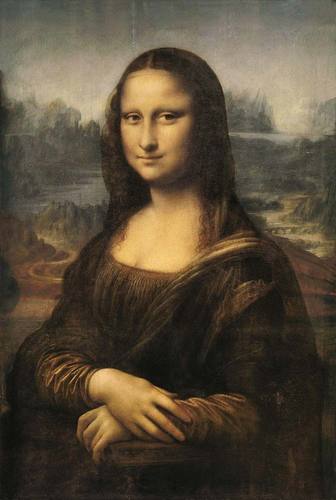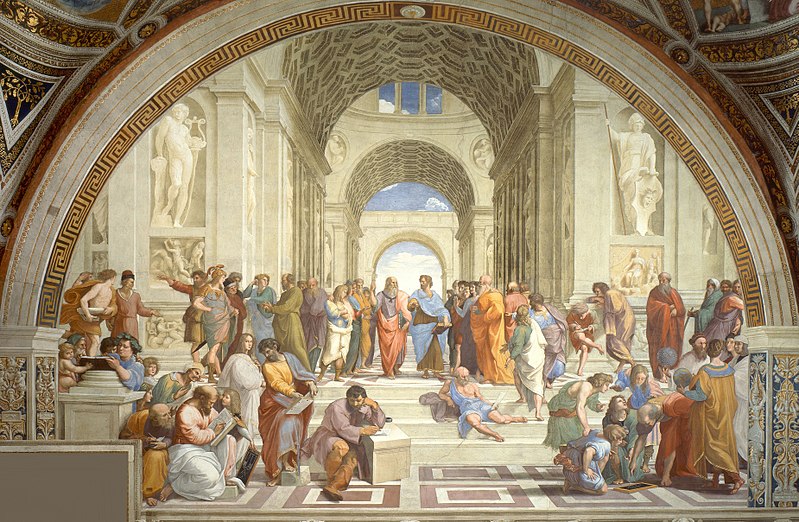The renaissance marked a period of revolution in art that has not been equaled to this day.
It spaned over three centuries from the 14th to the 17th century AD and marked a boom in classical based artworks that have stood the test of time.
Most notable were it’s artists and their return to classical thinking and the philosophies of the ancient Greeks and Romans.
Today such names as Da Vinci, Michelangelo, Botticelli and Raphael are all considered geniuses and their contribution to art, the humanities, science and philosophy is unequaled.
Renaissance paintings saw a quantum leap forward in terms of materials and techniques, with the linear perspective and highly accurate anatomical representation of the human form featuring heavily.
Famous Renaissance Paintings
1. Mona Lisa – Leonardo Da Vinci

The Mona Lisa could be considered the single most famous painting in the world and also the most famous smile to boot!
To his name Da Vinci has relatively few completed canvases when compared to other prolific proponents of the time.
However, all of his works are a considered true master pieces which is an accolade that is bestowed on very few people.
The Mona Lisa is a half height portrait and is believed to be of Lisa Gherardini who was the wife of a rich Florentine merchant by the name of Francesco del Giocondo.
Also Read: Famous Renaissance Portraits
The Mona Lisa is now owned by the French public and is on display at the Louvre, it is held in trust for the public and can never be sold.
It was once stolen by an Italian employee and taken back to Italy who claimed that is where it belongs. He was eventually caught and the piece was returned to the Louvre.
There are long ques everyday just to catch a glimpse of her famous smile.
She is easily the most famous painting of the renaissance period if not of all time.
2. The Last Supper – Leonardo Da Vinci

Like a lot of famous renaissance works of art The Last Supper is a religious scene and depicts the last supper of Jesus and his twelve apostles and was painted by Leonardo Da Vinci.
It is a not the typical fresco that is normally painted on walls instead Leonardo decided to use his preferred oil paints instead.
Leonardo is said to favor oil as it is slow drying and allowed him to make changes and take a slower more considered approach to the work.
Also Read: Leonardo da Vinci Paintings
Leonardo realized that if is he was to use oil paints then the natural moisture that permeates through most stone wall buildings would have to be sealed other wise it would ruin his work.
To counter this he applied a double layer of gesso, mastic and pitch.
Throughout it’s long history he painting had to be restored several times.
The result of both environmental and intentional damage, very little of the original top layer of oil painting is left.
3. The Creation of Adam – Michelangelo

The Creation of Adam was painted by Michelangelo in roughly 1508 to 1512.
It form the central image in the ceiling of the Sistine Chapels’ ceiling.
The image depicts God giving life to Adam from the Book of Genesis and has become one of the most iconic and reproduced images ever produced.
The total area is roughly over 500 square meters and it took Michelangelo over four years to finish what is one of the most complex and largest fresco paintings ever attempted.
In all there are some 300 figures, but the Creation of Adam focuses on God on the right giving life to Adam who represents man.
Also Read: Famous Renaissance Paintings
Adam is lying on the edge of the earth in a rather relaxed fashion and God is carried by his angels reaching across to Adam to give the gift of life through his touch.
To truly appreciate the grandeur of one of the renaissances finest art works you must walk under the ceiling of the Sistine chapel and gaze upwards.
4. Primavera – Sandro Botticelli

Sandro Botticelli is believed to have painted Primavera in 1482 the name in English means Spring and the painting is sometimes referred to as ‘Allegory of Spring‘.
The actual scene and what it represents is the cause of much debate among artistic scholars and commentators with some saying it portrays a mythical allegory and others the changing of the seasons.
Also Read: Famous Italian Art
It is one of the finest renaissance art examples and is not only of note due to it’s meaning but also in Botticelli’s use of color which was rather striking for the age that it was painted in.
5. The School of Athens – Raphael

The School of Athens is a fresco that was painted be Raphael between 1509 and 1511 in the Apostolic Palace in the Vatican.
It is painted in the Stanza della Segnatura which is on the second floor in the North wing of the Vatican Palace.
The painting features almost ever important Greek philosopher.
It is one of four large fresco’s painted in that room with each of the four representing the branches of human knowledge which are Justice, Philosophy, Poetry and the School of Athens.
The use of perspective features heavily in the composition and the eye is drawn towards the two central figures Plato on the left and Aristotle on the right.
On the left are philosophers that represent Plato’s philosophies and on the right philosophers that represent Aristotle’s philosophies with a sum total of 50 figures in the painting.
6. The Birth of Venus – Sandro Botticelli

One of Botticelli’s finest renaissance works of art The Birth of Venus features the Roman goddess Venus as she arrives on shore having been born fully grown at sea, she is delivered on a giant shell.
Sandro Botticelli was responsible for that other famous renaissance painting that depicts a mythological image the Primavera.
Also Read: Botticelli Paintings
Both great works of art were commissioned by the powerful banking dynasty the Medici who were extremely strong patrons of art in Florence.
Previous to this time the majority of works would have been painted on wood panels but the Birth of Venus is actually tempura on canvas.
Canvas had a distinct advantage over wood as in humid climates wood had a tendency to warp whereas canvas did not.
7. Sistine Madonna – Raphael

The Sistine Madonna was one of Raphael’s last great works of renaissance art, he died but a few short years later.
The painting depicts the Virgin Mary holding the baby Jesus flanking her in the image are Saint Sixtus and Saint Barbara, below her in the foreground are cherubs that gaze upwards towards Mary.
The painting was painted for the Benedictine Monks in the San Sisto Monastery Piacenza which was hung in pride of place near the alter.
Also Read: Female Renaissance Artists
It later found it’s way to Germany in 1754 to King Agustus III of Saxony, upon it’s arrival in Germany it caused considerable debate questioning the lines between art and religion.
The painting would later move to Moscow after World War II and then finally returning to Germany in 1955.
It is considered one of the most famous Renaissance paintings of the Virgin Mary and was a master class from Raphael in terms of light and shadow.
8. The Last Judgement – Michelangelo

The Last Judgement is massive fresco painted by Michelangelo that adorns the whole alter wall of the Sistine Chapel in the Vatican City.
It took Michelangelo over four years between 1536 and 1541 to complete due to not only it’s size but also the complexity and the number of figures.
He started working on it 25 years after the completion of the Sistine Chapel Ceiling and by that stage was considerably old at 67 by the time it was completed.
Originally all of the males were painted as nudes but they were later covered up by the addition of painted draperies.
Initially the reception was mixed between praise and criticism with the nudes being a major talking point as too was how muscular a lot of the figures were.
9. The Kiss of Judas – Giotto di Bondone

The Kiss of Judas is also known as the Betrayal of Christ and depicts the scene of Judas making Christ known to the officers of the Sanhedrin which led to his arrest and ultimate execution.
Also Read: Paintings of The Resurrection
It was painted by Giotto di Bondone and was commissioned by the powerful banking family the Scrovengi’s in the Scrovengi Chapel which was built by the family on the site of an ancient Roman arena.
The painting is probably most famous for the fact that it marked an end to the familiar medieval style of painting and heralded in the new wave of artistic revolution that was the early renaissance.
The series of fresco’s that Giotto painted for the rich banking family were considered at the time to be the most modern works of art of any artist.
10. The Assumption of the Virgin – Titan

The Assumption of the Virgin also known as the Frari assumption is a painting by Titan that resides at the high altar at the Basilica di Santa Maria Gloriosca dei Frari in Venice.
It was painted by Titan between 1515 and 1518 and is the largest altar piece in Venice.
For Titan it was the first time he sought to emulate the more modern dynamic scenes that Raphael and Michelangelo were becoming known for further south in Florence.
The painting is framed by massive marble columns and gilded edges and forms a rather striking piece when viewed from the other end of the church.
11. The Tempest – Giorgione

“The Tempest” is indeed one of Giorgione’s most famous and enigmatic works.
Painted around 1508, it depicts a tranquil landscape with a stormy sky in the background. In the foreground, a woman nurses an infant while a man stands beside her, gazing at the viewer.
The exact meaning of the painting remains uncertain, contributing to its enduring fascination. Various interpretations have been suggested, including allegorical, mythological, and even political readings.
The mysterious atmosphere, coupled with the ambiguity of the narrative, has made “The Tempest” a subject of much debate and intrigue among art historians and enthusiasts.
12. The Arnolfini Portrait – Jan van Eyck

The Arnolfini Portrait” is a famous oil painting by the Early Netherlandish artist Jan van Eyck, completed in 1434. It is also known as “The Arnolfini Wedding” or “The Arnolfini Marriage.”
The painting depicts a wealthy couple, Giovanni di Nicolao Arnolfini and his wife, possibly Jeanne Cenami, standing in a well-appointed room.
Key elements of the painting include:
- The elaborate clothing worn by the couple, symbolizing their wealth and social status.
- The mirror on the back wall, which reflects the couple and two additional figures believed to be witnesses to the marriage.
- The intricately detailed surroundings, including the chandelier, bed, and various objects that hold symbolic significance.
- The small dog at the feet of the woman, often interpreted as a symbol of fidelity or wealth.
“The Arnolfini Portrait” is celebrated for its meticulous attention to detail, mastery of light and shadow, and the rich symbolism embedded within the composition. It remains one of the most studied and debated works of art from the Northern Renaissance period.
13. The Annunciation – Fra Angelico

“The Annunciation” by Fra Angelico is a notable Renaissance painting depicting the angel Gabriel’s visit to the Virgin Mary. Key features include the central figures of Gabriel and Mary, set within a detailed architectural backdrop.
Symbolism such as the lily and dove convey purity and the Holy Spirit. Mary’s response varies, reflecting her humility or surprise. The painting’s portrayal of divine presence and Fra Angelico’s skillful composition make it a significant piece of Christian iconography.
